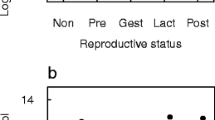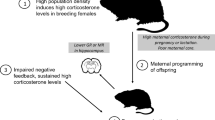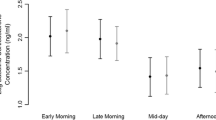Abstract
From a life history perspective, glucocorticoids secreted by the neuroendocrine system, integrating different sources of stress through an adaptive feedback mechanism, may have important consequences on individual fitness. Although stress responses have been the object of several investigations, few studies have explored the role of proximate mechanisms responsible for the potential trade-offs between physiological stress and life history traits integrating social and environmental stressors. In 2011 and 2012, we collected data on faecal cortisol metabolites (FCM) in a marked male population of Alpine chamois, within the Gran Paradiso National Park (Italy). Using a model selection approach we analysed the effect of potential etho-ecological stressors such as age, social status (territorial vs. non-territorial males), minimum temperature, snow depth and precipitation on FCM variation. To correctly interpret environmentally and socially induced stress responses, we conducted model selections over multiple temporal scales defined a priori: year, cold months, spring, warm months, mating season. Over the year, FCM levels showed a negative relationship with minimum temperature, but altogether, climatic stressors had negligible effects on glucocorticoid secretion, possibly owing to good adaptations of chamois to severe weather conditions. Age was negatively related to FCM during the rut, possibly due to greater experience of older males in agonistic contests. Social status was an important determinant of FCM excretion: while both the ‘stress of subordination’ and the ‘stress of domination’ hypotheses received some support in spring and during the mating season, respectively, previous data suggest that only the latter may have detrimental fitness consequences on male chamois.





Similar content being viewed by others
References
Altmann J (1974) Observational study of behaviour: sampling methods. Behaviour 49:227–267
Bartoń K (2013) MuMIn: multi-model inference. R package version 1.9.13
Bates D, Maechler M, Bolker B, Walker S (2014) lme4: linear mixed-effects models using Eigen and S4. R package version 1.1-5
Bateson P, Bradshaw EL (1997) Physiological effects of hunting red deer (Cervus elaphus). Proc R Soc Lond B 264:1707–1714
Blanchard DC, Saka RR, McEwen B, Weiss SM, Blanchard RJ (1993) Subordination stress: behavioral, brain, and neuroendocrine correlates. Behav Brain Res 58:113–121
Boonstra R (2004) Coping with changing northern environments: the role of the stress axis in birds and mammals. Integr Comp Biol 44:95–108
Brivio F, Grignolio S, Apollonio M (2010) To feed or not to feed? Testing different hypotheses on rut-induced hypophagia in a mountain ungulate. Ethology 116:406–415
Bubenik GA, Bubenik AB, Schams D, Leatherland JF (1983) Circadian and circannual rhythms of LH, FSH, testosterone (T), prolactin, cortisol, T3 and T4 in plasma of mature, male white tailed deer. Comp Biochem Physiol 76:37–45
Bubenik GA, Schams D, White RG, Rowell J, Blake J, Bartos L (1998) Seasonal levels of metabolic hormones and substrates in male and female reindeer (Rangifer tarandus). Comp Biochem Physiol C 120:307–315
Burnham KP, Anderson DR (2002) Model selection and multimodel inference, 2nd edn. Springer, New York
Cavigelli SA (1999) Behavioural patterns associated with fecal cortisol levels in free-ranging female ring-tailed lemurs, Lemur catta. Anim Behav 57:935–944
Cederna A, Lovari S (1985) The impact of tourism on chamois feeding activities in an area of the Abruzzo National Park. In: Lovari S (ed) The biology and management of mountain ungulates. Croom Helm, London, pp 212–215
Chapple RS, English AW, Mulley RC, Lepherd EE (1991) Haematology and serum biochemistry of captive unsedated chital deer (Axis (Cervus) axis) in Australia. J Wildl Dis 27:396–406
Corlatti L, Bassano B (2014) Contrasting alternative hypotheses to explain rut-induced hypophagia in territorial male chamois. Ethology 120:32–41
Corlatti L, Palme R, Frey-Roos F, Hackländer K (2011) Climatic cues and glucocorticoids in a free ranging riparian population of red deer (Cervus elaphus). Folia Zool 60:176–180
Corlatti L, Bethaz S, von Hardenberg A, Bassano B, Palme R, Lovari S (2012) Hormones, parasites and alternative mating tactics in Alpine chamois: identifying the mechanisms of life history trade-offs. Anim Behav 84:1061–1070
Corlatti L, Caroli M, Pietrocini V, Lovari S (2013) Rutting behaviour of territorial and nonterritorial male chamois: Is there a home advantage? Behav Proc 92:118–124
Creel S (2001) Social dominance and stress hormones. Trends Ecol Evol 16:491–497
Dalmau A, Ferret A, Chacon G, Manteca X (2007) Seasonal changes in fecal cortisol metabolites in Pyrenean chamois. J Wildl Manag 71:190–194
Dantzer R, Mormede P (1983) Stress in farm animals: a need for reevaluation. J Anim Sci 57:6–17
Dematteis A, Menzano A, Canavese G, Meneguz PG, Rossi L (2009) Anaesthesia of free-ranging Northern chamois (Rupicapra rupicapra) with xylazine/ketamine and reversal with atipamezole. Eur J Wildl Res 55:567–573
Fichtel C, Kraus C, Ganswindt A, Heistermann M (2007) Influence of reproductive season and rank on fecal glucocorticoid levels in free-ranging male Verreaux’s sifakas (Propithecus verreauxi). Horm Behav 51:640–648
Foley CAH, Papageorge S, Wasser SK (2001) Noninvasive stress and reproductive measures of social and ecological pressures in free-ranging African elephants. Conserv Biol 15:1134–1142
Folstad I, Karter AJ (1992) Parasites, bright males, and the immunocompetence handicap. Am Nat 139:603–622
Foster DW, McGarry JD (1988) Glucose, lipid, and protein metabolism. In: Griffin JE, Ojeda SR (eds) Textbook of endocrine physiology. Oxford University Press, New York, pp 349–374
Ganswindt A, Palme R, Heistermann M, Borragan S, Hodges JK (2003) Non-invasive assessment of adrenocortical function in the male African elephant (Loxodonta africana) and its relation to musth. Gen Comp Endocrinol 134:156–166
Ganswindt A, Münscher S, Henley M, Henley S, Heistermann M, Palme R, Thompson P, Bertschinger H (2010) Endocrine correlates of musth and the impact of ecological and social factors in free-ranging African elephants (Loxodonta africana). Horm Beh 57:506–514
Garcia Pereira RJ, Barbanti Duarte JM, Negrão JA (2006) Effects of environmental conditions, human activity, reproduction, antler cycle and grouping on fecal glucocorticoids of free-ranging Pampas deer stags (Ozotoceros bezoarticus bezoarticus). Horm Behav 49:114–122
Garel M, Loison A, Jullien J-M, Dubray D, Maillard D, Gaillard J-M (2009) Sex-specific growth in Alpine chamois. J Mammal 90:954–960
Haymerle A (2013) Physiological adaptations to extreme climates in Alpine chamois. Proceedings of the international workshop on chamois, 26 November, Val di Rhêmes (AO), Gran Paradiso National Park
Hoby S, Schwarzenberger F, Doherr MG, Robert N, Walzer C (2006) Steroid hormone related male biased parasitism in chamois, Rupicapra rupicapra rupicapra. Vet Parasitol 138:337–348
Hothorn T, Bretz F, Westfall P (2008) Simultaneous inference in general parametric models. Biom J 50:346–363
Huber S, Palme R, Arnold W (2003a) Effects of season, sex, and sample collection on concentration of fecal cortisol metabolites in red deer (Cervus elaphus). Gen Comp Endocrinol 130:48–54
Huber S, Palme R, Zenker W, Möstl E (2003b) Non-invasive monitoring of the adrenocortical response in red deer. J Wildl Manag 67:258–266
Ingram JR, Crockford JN, Matthews LR (1999) Ultradian, circadian and seasonal rhythms in cortisol secretion and adrenal responsiveness to ACTH and yarding in unrestrained red deer (Cervus elaphus) stags. J Endocrinol 162:289–300
Kleinsasser C, Graml C, Klobetz-Rassam E, Barth K, Waiblinger S, Palme R (2010) Physiological validation of a non-invasive method for measuring adrenocortical activity in goats. Wiener Tierärztl Mschrift - Vet Med Austria 97:259–262
Konjević D, Janicki Z, Slavica A, Severin K, Krapinec K, Božić F, Palme R (2011) Non-invasive monitoring of adrenocortical activity in free-ranging fallow deer (Dama dama L.). Eur J Wildlife Res 57:77–81
Krämer A (1969) Soziale Organisation und Sozialverhalten einer Gemspopulation Rupicapra rupicapra der Alpen. Zeit Tierpsychol 26:889–964
Lepschy M, Touma C, Palme R (2010) Faecal glucocorticoid metabolites: how to express yourself — comparison of absolute amounts versus concentrations in samples from a study in laboratory rats. Lab Anim 44:192–198
Lovari S, Scala C (1980) Revision of Rupicapra genus. A statistical re-evaluation of Couturier’s data on the morphometry of six chamois subspecies. Boll Zool 47:113–124
Mashburn KL, Atkinson S (2007) Seasonal and predator influences on adrenal function in adult Steller sea lions: gender matters. Gen Comp Endocrinol 150:246–252
Maynard-Smith J (1982) Evolution and the theory of games. Cambridge University Press, Cambridge
Mooring MS, Patton ML, Lance VA, Hall BM, Schaad EW, Fetter GA, Fortin SS, McPeak KM (2006) Glucocorticoids of bison bulls in relation to social status. Horm Beh 49:369–375
Möstl E, Palme R (2002) Hormones as indicators of stress. Domest Anim Endocrin 23:67–74
Möstl E, Maggs JL, Schrötter G, Besenfelder U, Palme R (2002) Measurement of cortisol metabolites in faeces of ruminants. Vet Res Commun 26:127–139
Nakagawa S, Schielzeth H (2013) A general and simple method for obtaining R 2 from generalized linear mixed-effects models. Methods Ecol Evol 4:133–142
Nováková M, Palme R, Kutalová H, Jansky L, Frynta D (2008) The effects of sex, age and commensal way of life on levels of fecal glucocorticoid metabolites in spiny mice (Acomys cahirinus). Physiol Behav 95:187–193
Nussberger B, Ingold P (2006) Effects of radio-collars on behaviour of Alpine chamois Rupicapra rupicapra rupicapra. Wildl Biol 12:339–343
Palme R, Touma C, Arias N, Dominchin MF, Lepschy M (2013) Steroid extraction: get the best out of faecal samples. Wiener Tierärztl Mschrift - Vet Med Austria 100:238–246
Piepho H-P (2004) An algorithm for a letter-based representation of all-pairwise comparisons. J Comput Graph Stat 13:456–466
R Development Core Team (2013) R: a language and environment for statistical computing (3.0.1). R Foundation for Statistical Computing
Rehnus M, Hackländer K, Palme R (2009) A non-invasive method for measuring glucocorticoid metabolites (GCM) in mountain hares (Lepus timidus). Eur J Wildl Res 55:615–620
Rehnus M, Palme R, Filli F, Hackländer K (2010) Seasonal glucocorticoid secretion in mountain hares (Lepus timidus). Mammalia 74:347–350
Rehnus M, Wehrle M, Palme R (2014) Mountain hares (Lepus timidus) and tourism: stress events and reactions. J Appl Ecol 51:6–12
Richards SA, Whittingham MJ, Stephens PA (2011) Model selection and model averaging in behavioural ecology: the utility of the IT-AIC framework. Behav Ecol Sociobiol 65:77–89
RStudio (2013) RStudio: integrated development environment for R (Version 0.98.501) [computer software]. Boston, MA
Rubenstein DR (2007) Stress hormones and sociality: integrating social and environmental stressors. Proc R Soc B 274:967–975
Rughetti M, Festa-Bianchet M (2011) Seasonal changes in sexual-size dimorphism in northern chamois. J Zool 28:257–264
Rughetti M, Toïgo C, von Hardenberg A, Rocchia E, Festa-Bianchet M (2011) Effects of an exceptionally snowy winter on chamois survival. Acta Theriol 56:329–333
Saltz D, White GC (1991) Urinary cortisol and urea nitrogen responses to winter stress in mule deer. J Wildl Manag 55:1–16
Sands J, Creel S (2004) Social dominance, aggression and faecal glucocorticoid levels in a wild population of wolves, Canis lupus. Anim Behav 67:387–396
Sapolsky RM (1992) Neuroendocrinology of the stress response. In: Becker JB, Breedlove SM, Crews D (eds) Behavioral endocrinology. MIT Press, Cambridge, pp 287–324
Sapolsky RM (2002) Endocrinology of the stress response. In: Becker JB, Breedlove SM, Crews D, McCarthy MM (eds) Behavioral endocrinology, 2nd edn. MIT Press, Cambridge, pp 409–450
Sapolsky RM, Romero LM, Munck AU (2000) How do glucocorticoids influence stress response? Integrating permissive, suppressive, stimulatory and preparative actions. Endocrine Rev 21:55–89
Schröder W, von Elsner-Schack IV (1985) Correct age determination in chamois. In: Lovari S (ed) The biology and management of mountain ungulates. Croom Helm, London, pp 67–70
Sheriff MJ, Dantzer B, Delehanty B, Palme R, Boonstra R (2011) Measuring stress in wildlife: techniques for quantifying glucocorticoids. Oecologia 166:869–887
Taborsky M, Oliveira RF, Brockmann HJ (2008) The evolution of alternative reproductive tactics: concepts and questions. In: Oliveira RF, Taborsky M, Brockmann HJ (eds) Alternative reproductive tactics: an integrative approach. Cambridge University Press, Cambridge, pp 1–22
von Hardenberg A, Bassano B, Peracino A, Lovari S (2000) Male Alpine chamois occupy territories at hotspots before the mating season. Ethology 106:617–630
Yousef MK, Cameron RD, Luick JR (1971) Seasonal changes in hydrocortisone secretion rate in reindeer, Rangifer tarandus. Comp Biochem Physiol 40:495–501
Zwijacz-Kozica T, Selva N, Barja I, Silván G, Martínez-Fernández L, Illera JC, Jodłowski M (2013) Concentration of fecal cortisol metabolites in chamois in relation to tourist pressure in TATRA National Park (South Poland). Acta Theriol 58:215–222
Acknowledgements
We thank the Gran Paradiso National Park agency for logistic support. We thank in particular B. Bassano for his help in capturing chamois and for the logistic support to carry out glucocorticoid analysis. We are indebted to all the students and interns that helped collecting data in the field over the years. We thank E. Klobetz-Rassam for technical assistance in the assessment of faecal cortisol metabolites, F. Ferretti, S. Thatje and an anonymous reviewer for helpful comments on the manuscript. We also thank IREN Energia for kindly providing us with climate data from the Serrù meteorological station. LC participated in the captures of animals, collected data in the field, did the statistical analyses and wrote the first draft of this paper. RP supervised the laboratory analysis and participated in writing up this paper. SL supervised the planning of this paper, from data analysis to writing.
Author information
Authors and Affiliations
Corresponding author
Additional information
Communicated by: Sven Thatje
Rights and permissions
About this article
Cite this article
Corlatti, L., Palme, R. & Lovari, S. Physiological response to etho-ecological stressors in male Alpine chamois: timescale matters!. Naturwissenschaften 101, 577–586 (2014). https://doi.org/10.1007/s00114-014-1195-x
Received:
Revised:
Accepted:
Published:
Issue Date:
DOI: https://doi.org/10.1007/s00114-014-1195-x




